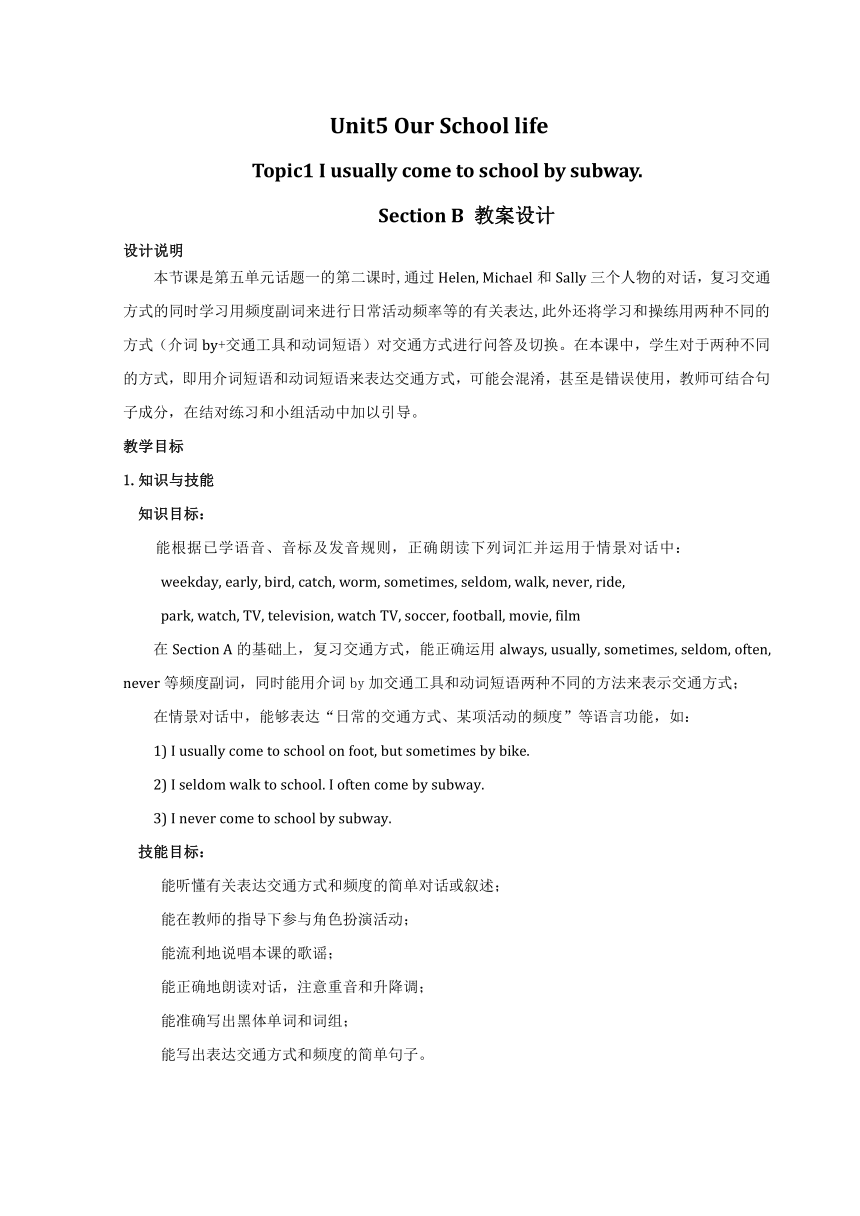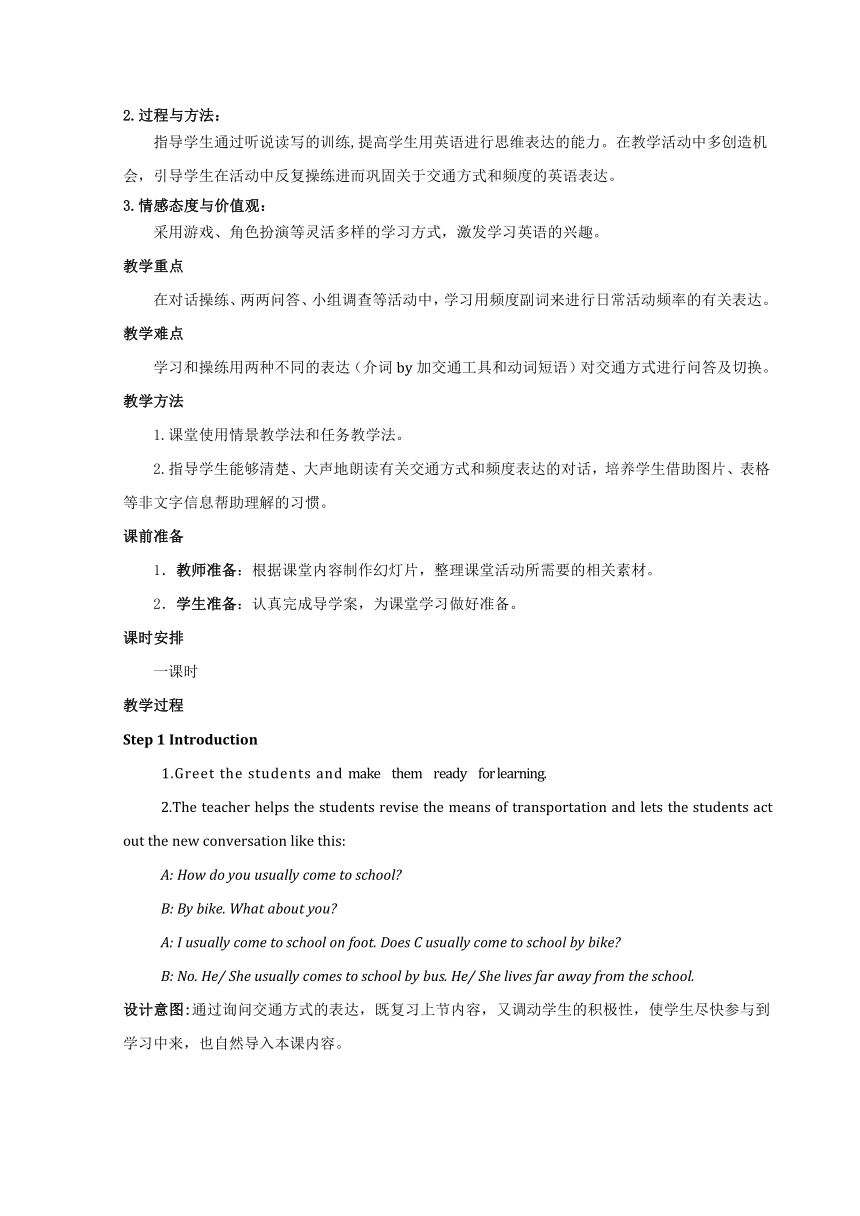八年级下册:Unit5 Feeling happy. Topic1 I’m so happy.Section B 教案设计
文档属性
| 名称 | 八年级下册:Unit5 Feeling happy. Topic1 I’m so happy.Section B 教案设计 |  | |
| 格式 | zip | ||
| 文件大小 | 122.4KB | ||
| 资源类型 | 教案 | ||
| 版本资源 | 仁爱科普版 | ||
| 科目 | 英语 | ||
| 更新时间 | 2017-07-22 07:10:07 | ||
图片预览


文档简介
Unit5
Our
School
life
Topic1
I
usually
come
to
school
by
subway.
Section
B
教案设计
设计说明
本节课是第五单元话题一的第二课时,通过Helen,
Michael和Sally三个人物的对话,复习交通方式的同时学习用频度副词来进行日常活动频率等的有关表达,此外还将学习和操练用两种不同的方式(介词by+交通工具和动词短语)对交通方式进行问答及切换。在本课中,学生对于两种不同的方式,即用介词短语和动词短语来表达交通方式,可能会混淆,甚至是错误使用,教师可结合句子成分,在结对练习和小组活动中加以引导。
教学目标
1.知识与技能
知识目标:
能根据已学语音、音标及发音规则,正确朗读下列词汇并运用于情景对话中:
weekday,
early,
bird,
catch,
worm,
sometimes,
seldom,
walk,
never,
ride,
park,
watch,
TV,
television,
watch
TV,
soccer,
football,
movie,
film
在Section
A的基础上,复习交通方式,能正确运用always,
usually,
sometimes,
seldom,
often,
never等频度副词,同时能用介词by加交通工具和动词短语两种不同的方法来表示交通方式;
在情景对话中,能够表达“日常的交通方式、某项活动的频度”等语言功能,如:
1)
I
usually
come
to
school
on
foot,
but
sometimes
by
bike.
2)
I
seldom
walk
to
school.
I
often
come
by
subway.
3)
I
never
come
to
school
by
subway.
技能目标:
能听懂有关表达交通方式和频度的简单对话或叙述;
能在教师的指导下参与角色扮演活动;
能流利地说唱本课的歌谣;
能正确地朗读对话,注意重音和升降调;
能准确写出黑体单词和词组;
能写出表达交通方式和频度的简单句子。
2.过程与方法:
指导学生通过听说读写的训练,提高学生用英语进行思维表达的能力。在教学活动中多创造机
会,引导学生在活动中反复操练进而巩固关于交通方式和频度的英语表达。
3.情感态度与价值观:
采用游戏、角色扮演等灵活多样的学习方式,激发学习英语的兴趣。
教学重点
在对话操练、两两问答、小组调查等活动中,学习用频度副词来进行日常活动频率的有关表达。
教学难点
学习和操练用两种不同的表达(介词by加交通工具和动词短语)对交通方式进行问答及切换。
教学方法
1.课堂使用情景教学法和任务教学法。
2.指导学生能够清楚、大声地朗读有关交通方式和频度表达的对话,培养学生借助图片、表格等非文字信息帮助理解的习惯。
课前准备
1.教师准备:根据课堂内容制作幻灯片,整理课堂活动所需要的相关素材。
2.学生准备:认真完成导学案,为课堂学习做好准备。
课时安排
一课时
教学过程
Step
1
Introduction
1.Greet
the
students
and
make
them
ready
for
learning.
2.The
teacher
helps
the
students
revise
the
means
of
transportation
and
lets
the
students
act
out
the
new
conversation
like
this:
A:
How
do
you
usually
come
to
school
B:
By
bike.
What
about
you
A:
I
usually
come
to
school
on
foot.
Does
C
usually
come
to
school
by
bike
B:
No.
He/
She
usually
comes
to
school
by
bus.
He/
She
lives
far
away
from
the
school.
设计意图:通过询问交通方式的表达,既复习上节内容,又调动学生的积极性,使学生尽快参与到学习中来,也自然导入本课内容。
Step2
Presentation
1.Show
the
pictures
and
guide
the
students
to
learn
the
new
words.
2.The
teacher
leads
to
the
saying
“The
early
bird
catches
the
worm”
by
asking
and
answering
.
3.Let
the
students
look
at
the
picture
in
1a
and
read
the
sentences
in
1b,
trying
to
predict
the
conversation
in
1a.
4.
Finish
1b.
Let
the
students
listen
to
1a
and
complete
the
sentences
with
usually,
always,
often,
sometimes,
seldom
or
never.
Then
check
the
answers.
设计意图:呈现本课的重点单词和短语,导入1a对话,学习频度副词的用法,同时为下个活动的学习做好铺垫。
Step3
Consolidation
1.
Let
the
students
watch
the
flash
of
1a
and
read
after
it,paying
attention
to
the
sentence
intonation
and
pronunciation.
2.Let
the
students
act
out
the
dialog
according
to
the
words
and
phrases
given.
3.
Finish
1c.
The
teacher
asks
the
students
to
read
1a
again
and
fill
in
the
blanks
with
the
correct
words
from
the
list
in
1b
individually.
Then
check
the
answers
.
设计意图:引导学生在1a对话学习中反复操练,进一步巩固关于交通方式和频度的英语表达。
Step4
Practice
1.The
teacher
guides
the
students
to
study
the
example
in
2a
to
understand
the
two
ways
of
expressing
means
of
transportation
and
fill
in
the
blanks.
Then
discuss
and
check
the
answers
in
groups
and
try
to
find
the
rules.
2.
The
teacher
helps
the
students
check
the
rules
of
two
ways
of
expressing
the
same
meaning
and
sum
up
the
key
points.
3.Finish
2b.Let
the
students
ask
and
answer
questions
about
the
pictures
in
2a
in
pairs,
using
two
ways
of
expressing
means
of
transportation.
Then
some
pairs
act
out
the
dialogs.
They
may
act
out
like
this:
A:
How
does
Li
Xiang
go
to
school
B:
He
often
goes
to
school
by
bike.
/
He
often
rides
a
bike
to
school.
4.Let
the
students
read
the
form
in
3
before
listening
and
predict
the
listening
material.
Learn
the
new
words:
watch
TV,
soccer/football,
movie/film.
Then
listen
to
the
passage
about
Nancy’s
activities
and
check
the
correct
answers
individually.
Then
check
the
answers.
5.Finish
4.
Let
the
students
look
at
the
pictures
in
4
and
write
down
the
means
of
transportation
in
the
pictures.
Then
match
the
first
four
sentences
with
the
pictures.
The
teacher
checks
the
answers
.
Then
the
whole
class
watch
the
flash
and
learn
to
chant
together.
设计意图:通过练习活动,学生学习用介词短语和动词短语来表达交通方式,并结合自身实际进一步练习和巩固,达到学以致用的教学目的。
Step5
Production
1.
The
teacher
asks
two
students
to
sum
up
the
key
points
according
to
the
blackboard.
2.Let
students
read
through
what
they
have
learnt
after
the
teacher.
3.Assign
the
homework:
1).Memorize
the
new
words
and
phrases.
2).Review
the
Adverbs
of
Frequency.
3).Practice
the
means
of
transportation
in
different
expressions.
4).Preview
Section
C-1a.
设计意图:引导学生对本节课所学知识点进行总结归纳,培养学生自主学习的习惯,布置作业,对本节课进行反馈,为教学反思和下一步教学提供有力的依据。
板书设计
Unit5
Topic
1
Section
B
I
always
get
up
at
six
o’clock.
weekday
early
The
early
bird
catches
the
worm.
bird
catch
I
usually
come
to
school
on
foot,
worm
sometimes
but
sometimes
by
bike.
seldom
walk
I
seldom
walk
to
school.
never
ride
I
often
come
by
subway.
park
watch
TV
I
never
come
to
school
by
subway.
TV=television
soccer=football
I
always
take
a
bus.
movie=film
Li
Xiang
often
comes
to
school
by
bike.
Li
Xiang
often
rides
a
bike
to
school.
教学反思
在这节课中,学生在听、说、写、唱的活动中,学习并操练了频度副词以及交通方式。因为频度副词听上去相差甚微,学生可能容易混淆,教师可结合图示、百分比等直观材料帮助学生加以巩固。此外,学生对于用“介词by加交通工具”和“动词短语”两种不同的方式来表达交通方式还不够熟练,甚至会出现错误使用,因此,教师可以在课外额外设置一些笔头练习,让学生在介词短语和动词短语互相转换的练习中不断熟练和进一步巩固。
Our
School
life
Topic1
I
usually
come
to
school
by
subway.
Section
B
教案设计
设计说明
本节课是第五单元话题一的第二课时,通过Helen,
Michael和Sally三个人物的对话,复习交通方式的同时学习用频度副词来进行日常活动频率等的有关表达,此外还将学习和操练用两种不同的方式(介词by+交通工具和动词短语)对交通方式进行问答及切换。在本课中,学生对于两种不同的方式,即用介词短语和动词短语来表达交通方式,可能会混淆,甚至是错误使用,教师可结合句子成分,在结对练习和小组活动中加以引导。
教学目标
1.知识与技能
知识目标:
能根据已学语音、音标及发音规则,正确朗读下列词汇并运用于情景对话中:
weekday,
early,
bird,
catch,
worm,
sometimes,
seldom,
walk,
never,
ride,
park,
watch,
TV,
television,
watch
TV,
soccer,
football,
movie,
film
在Section
A的基础上,复习交通方式,能正确运用always,
usually,
sometimes,
seldom,
often,
never等频度副词,同时能用介词by加交通工具和动词短语两种不同的方法来表示交通方式;
在情景对话中,能够表达“日常的交通方式、某项活动的频度”等语言功能,如:
1)
I
usually
come
to
school
on
foot,
but
sometimes
by
bike.
2)
I
seldom
walk
to
school.
I
often
come
by
subway.
3)
I
never
come
to
school
by
subway.
技能目标:
能听懂有关表达交通方式和频度的简单对话或叙述;
能在教师的指导下参与角色扮演活动;
能流利地说唱本课的歌谣;
能正确地朗读对话,注意重音和升降调;
能准确写出黑体单词和词组;
能写出表达交通方式和频度的简单句子。
2.过程与方法:
指导学生通过听说读写的训练,提高学生用英语进行思维表达的能力。在教学活动中多创造机
会,引导学生在活动中反复操练进而巩固关于交通方式和频度的英语表达。
3.情感态度与价值观:
采用游戏、角色扮演等灵活多样的学习方式,激发学习英语的兴趣。
教学重点
在对话操练、两两问答、小组调查等活动中,学习用频度副词来进行日常活动频率的有关表达。
教学难点
学习和操练用两种不同的表达(介词by加交通工具和动词短语)对交通方式进行问答及切换。
教学方法
1.课堂使用情景教学法和任务教学法。
2.指导学生能够清楚、大声地朗读有关交通方式和频度表达的对话,培养学生借助图片、表格等非文字信息帮助理解的习惯。
课前准备
1.教师准备:根据课堂内容制作幻灯片,整理课堂活动所需要的相关素材。
2.学生准备:认真完成导学案,为课堂学习做好准备。
课时安排
一课时
教学过程
Step
1
Introduction
1.Greet
the
students
and
make
them
ready
for
learning.
2.The
teacher
helps
the
students
revise
the
means
of
transportation
and
lets
the
students
act
out
the
new
conversation
like
this:
A:
How
do
you
usually
come
to
school
B:
By
bike.
What
about
you
A:
I
usually
come
to
school
on
foot.
Does
C
usually
come
to
school
by
bike
B:
No.
He/
She
usually
comes
to
school
by
bus.
He/
She
lives
far
away
from
the
school.
设计意图:通过询问交通方式的表达,既复习上节内容,又调动学生的积极性,使学生尽快参与到学习中来,也自然导入本课内容。
Step2
Presentation
1.Show
the
pictures
and
guide
the
students
to
learn
the
new
words.
2.The
teacher
leads
to
the
saying
“The
early
bird
catches
the
worm”
by
asking
and
answering
.
3.Let
the
students
look
at
the
picture
in
1a
and
read
the
sentences
in
1b,
trying
to
predict
the
conversation
in
1a.
4.
Finish
1b.
Let
the
students
listen
to
1a
and
complete
the
sentences
with
usually,
always,
often,
sometimes,
seldom
or
never.
Then
check
the
answers.
设计意图:呈现本课的重点单词和短语,导入1a对话,学习频度副词的用法,同时为下个活动的学习做好铺垫。
Step3
Consolidation
1.
Let
the
students
watch
the
flash
of
1a
and
read
after
it,paying
attention
to
the
sentence
intonation
and
pronunciation.
2.Let
the
students
act
out
the
dialog
according
to
the
words
and
phrases
given.
3.
Finish
1c.
The
teacher
asks
the
students
to
read
1a
again
and
fill
in
the
blanks
with
the
correct
words
from
the
list
in
1b
individually.
Then
check
the
answers
.
设计意图:引导学生在1a对话学习中反复操练,进一步巩固关于交通方式和频度的英语表达。
Step4
Practice
1.The
teacher
guides
the
students
to
study
the
example
in
2a
to
understand
the
two
ways
of
expressing
means
of
transportation
and
fill
in
the
blanks.
Then
discuss
and
check
the
answers
in
groups
and
try
to
find
the
rules.
2.
The
teacher
helps
the
students
check
the
rules
of
two
ways
of
expressing
the
same
meaning
and
sum
up
the
key
points.
3.Finish
2b.Let
the
students
ask
and
answer
questions
about
the
pictures
in
2a
in
pairs,
using
two
ways
of
expressing
means
of
transportation.
Then
some
pairs
act
out
the
dialogs.
They
may
act
out
like
this:
A:
How
does
Li
Xiang
go
to
school
B:
He
often
goes
to
school
by
bike.
/
He
often
rides
a
bike
to
school.
4.Let
the
students
read
the
form
in
3
before
listening
and
predict
the
listening
material.
Learn
the
new
words:
watch
TV,
soccer/football,
movie/film.
Then
listen
to
the
passage
about
Nancy’s
activities
and
check
the
correct
answers
individually.
Then
check
the
answers.
5.Finish
4.
Let
the
students
look
at
the
pictures
in
4
and
write
down
the
means
of
transportation
in
the
pictures.
Then
match
the
first
four
sentences
with
the
pictures.
The
teacher
checks
the
answers
.
Then
the
whole
class
watch
the
flash
and
learn
to
chant
together.
设计意图:通过练习活动,学生学习用介词短语和动词短语来表达交通方式,并结合自身实际进一步练习和巩固,达到学以致用的教学目的。
Step5
Production
1.
The
teacher
asks
two
students
to
sum
up
the
key
points
according
to
the
blackboard.
2.Let
students
read
through
what
they
have
learnt
after
the
teacher.
3.Assign
the
homework:
1).Memorize
the
new
words
and
phrases.
2).Review
the
Adverbs
of
Frequency.
3).Practice
the
means
of
transportation
in
different
expressions.
4).Preview
Section
C-1a.
设计意图:引导学生对本节课所学知识点进行总结归纳,培养学生自主学习的习惯,布置作业,对本节课进行反馈,为教学反思和下一步教学提供有力的依据。
板书设计
Unit5
Topic
1
Section
B
I
always
get
up
at
six
o’clock.
weekday
early
The
early
bird
catches
the
worm.
bird
catch
I
usually
come
to
school
on
foot,
worm
sometimes
but
sometimes
by
bike.
seldom
walk
I
seldom
walk
to
school.
never
ride
I
often
come
by
subway.
park
watch
TV
I
never
come
to
school
by
subway.
TV=television
soccer=football
I
always
take
a
bus.
movie=film
Li
Xiang
often
comes
to
school
by
bike.
Li
Xiang
often
rides
a
bike
to
school.
教学反思
在这节课中,学生在听、说、写、唱的活动中,学习并操练了频度副词以及交通方式。因为频度副词听上去相差甚微,学生可能容易混淆,教师可结合图示、百分比等直观材料帮助学生加以巩固。此外,学生对于用“介词by加交通工具”和“动词短语”两种不同的方式来表达交通方式还不够熟练,甚至会出现错误使用,因此,教师可以在课外额外设置一些笔头练习,让学生在介词短语和动词短语互相转换的练习中不断熟练和进一步巩固。
同课章节目录
- Unit 5 Feeling excited
- Topic 1 You look excited
- Topic 2 I’m feeling better now.
- Topic 3 Many things can affect our feelings.
- Unit 6 Enjoying Cycling
- Topic 1 We're going on a three-day visit to Mount
- Topic 2 How about exploring Tian’anmen Square?
- Topic 3 Bicycle riding is good exercise.
- Unit 7 Food festival
- Topic 1 We’re preparing for a food festival.
- Topic 2 I’m not sure whether I can cook it well.
- Topic 3 I Cooked the Most Successfully
- Unit 8 Our Clothes
- Topic 1 We will have a class fashion show.
- Topic 2 We can design our own uniforms.
- Topic 3 He said the fashion show was wonderful.
